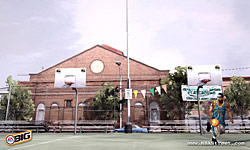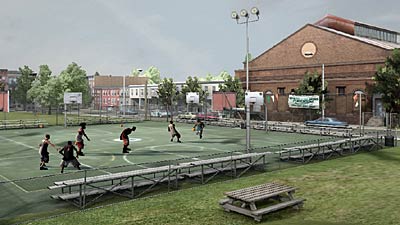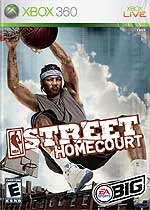NBA Jam, evolved
Everyone that remembers NBA Jam probably mainly remembers the over the top dunks, the flaming ball, and the obnoxious announcer. This game took the excitement of basketball and intensified it by exaggerating the players’ abilities, giving them the superhuman talents of soaring through the air unrealistically and dunking the ball time and again without much effort. While the gameplay was fun, it was far from deep, and rarely stood up to long gaming sessions.

The NBA Street series has followed in this tradition, giving the player exaggerated gameplay while trying to infuse a deeper experience. Homecourt, which is the fourth game in the series and the first to hit the next-gen, has nearly perfected this formula, giving us outrageous basketball gaming that isn’t just mindless fun.
The focus in Homecourt is just that: the homecourt. The different venues in the game are all based on various NBA players’ homecourts in their hometowns. A lot of emphasis has been placed on recreating the different courts as accurately as possible, infusing each different environment with its own life. However, even with this emphasis on the different courts, the gameplay steals the show.
One new addition to the gameplay is the dribble mechanics. There are two buttons to perform trick dribbles, one used to crossover, the other to perform a trick move. Different moves can be created by varying the pace of the button presses. For example, pressing the crossover button rapidly causes the character to dribble just as rapidly, while slowing down the pace conversely slows the crossover. Pressing the trick button at different times or different paces performs different tricks as well. In addition to all of this, the bumper buttons act as modifiers, effectively switching the crossover to either a between the legs dribble or a behind the back dribble, and similarly affecting the trick button. Tricks also vary when defenders get close, as the character can confuse opponents by sneaking the ball between defenders’ legs, bounce the ball off their heads, or even uprooting them. These elements combine to create tons of options for simply dribbling the ball upcourt in a flashy way.
Another new inclusion is the double dunk. When a baller sails through the air to complete a dunk, a meter appears onscreen that fills as the player approaches the basket. If the player can fill the meter completely, the character will dunk the ball twice in fantastic and ridiculous ways, such as dunking the ball, catching it between his feet, flipping the ball back into the air, and catching it for another dunk. This gives the player the opportunity to make two-pointers even with a team that can’t shoot from beyond the arc. However, if the player allows the meter to fill too far, the character misses the dunk embarrassingly.

Gamebreakers are still used in the game, although they are more interactive than before. Gamebreakers are basically super-sequences that occur when a team has sufficiently filled their tricks meter, which is done by completing outrageous tricks and then scoring. These Gamebreakers can change to momentum of almost any game, as an activated gamebreaker subtracts one point from the opposing team and the team using the gamebreaker can score many points off a well executed play. Gamebreakers can be stopped and stolen with effort, however, so when one is activated, the opposing team shouldn’t give up, as they’ve had to do in past iterations.
With all of these new inclusions, there is one major weakness. The gameplay emphasizes dunks over shooting to the point that jumpshots are almost pointless. Each player can jump to ridiculous heights in the air, so if a player shoots the ball with defenders near the goal, it is almost certainly going to get blocked. A pumpfake might trick the closest defender, but there is almost certainly another near the basket, especially if the player is trying to shoot from long range. There are numerous times when I made the computer turnover the ball due to a shot clock violation (the shot clock resets when you score, not when you shoot) because I’d blocked his shooting attempts multiple times in a row. This is especially pronounced in the shots-only matches, where dunks don’t add points to the score.

There isn’t much in the way of a story mode in Homecourt. In between new sections, the player is often treated to a short documentary type film, introducing a player or their court. Many of the voiceovers are performed by the actual NBA player, although a few are done by an announcer. However, after these shorts, the player is thrust upon a new court where he must choose a team and complete challenges, such as winning an all dunks game against other players or being the first team to lead by three. There are rivalries and complaints from your teammates when you misuse or underuse them, but all in all, there isn’t much drama or story to Homecourt beyond simple streetball.
There also isn’t much in the way of different modes. The Homecourt challenge is the “story mode.” Gamebreaker Battle is a mode where only points scored during a Gamebreaker count. Trick Battle has the teams only scoring when they fill their trick meter, and regular shots and dunks are just dressing. Back to Basics eschews Trick points and Gamebreakers for regular (albeit with still ridiculously high-flying players) basketball. These modes translate to the online arena as well, letting gamers challenger others online. The create-a-baller is a little dry too, as you can only create a character using a mixture of two other ballers’ faces. Although you can make slight adjustments, the customization is severely lacking.
